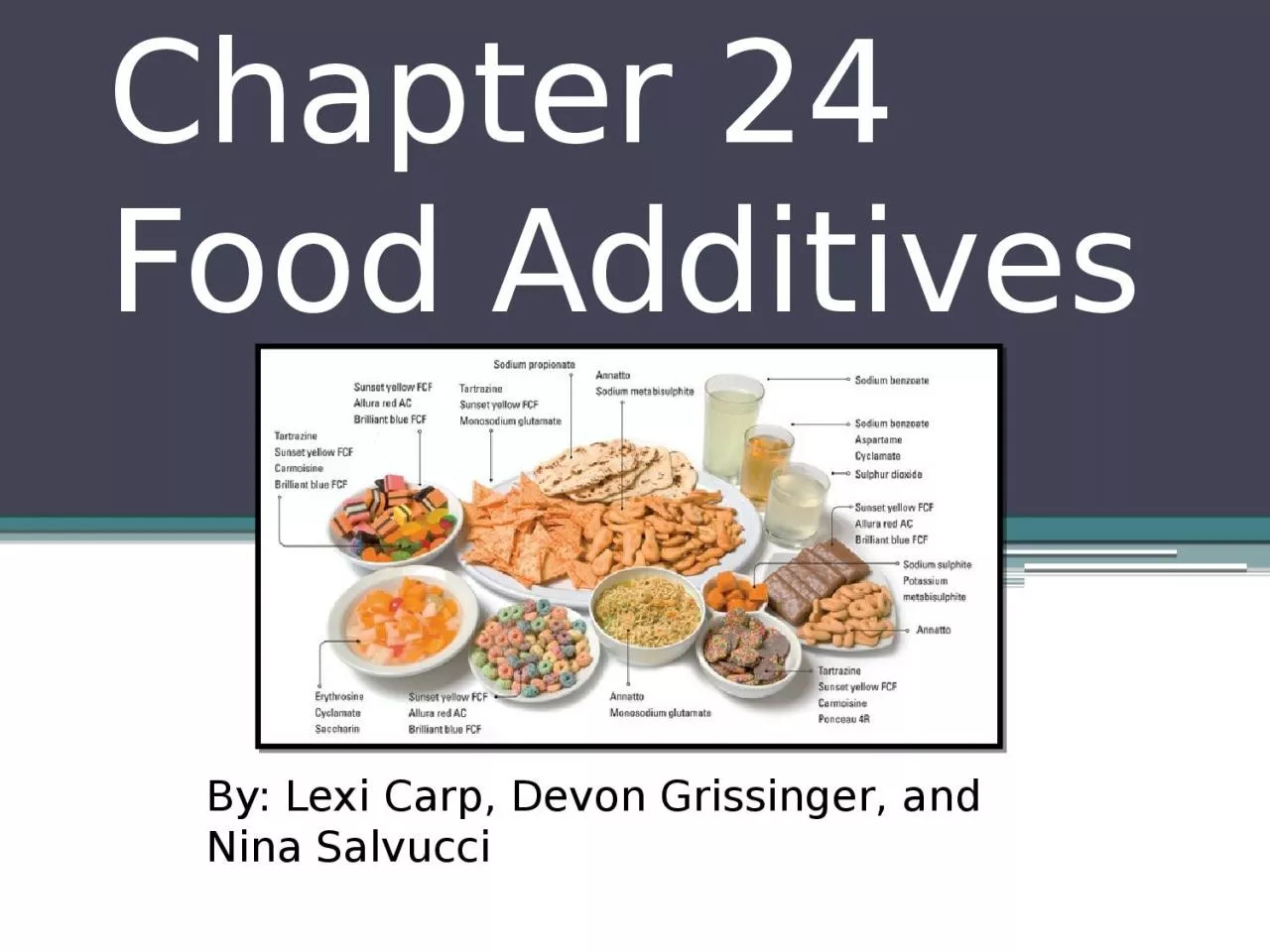

By Lexi Carp Devon Grissinger and Nina Salvucci Objectives and Vocabulary Objectives Identify common food additives and their uses Compare natural and synthetic additives Explain how additives are regulated ID: 1038030
Download Presentation The PPT/PDF document "Chapter 24 Food Additives" is the property of its rightful owner. Permission is granted to download and print the materials on this web site for personal, non-commercial use only, and to display it on your personal computer provided you do not modify the materials and that you retain all copyright notices contained in the materials. By downloading content from our website, you accept the terms of this agreement.
1. Chapter 24Food AdditivesBy: Lexi Carp, Devon Grissinger, and Nina Salvucci
2. Objectives and VocabularyObjectives:Identify common food additives and their usesCompare natural and synthetic additivesExplain how additives are regulated Identify general and specific uses of preservatives Compare methods for adding nutrients to foodsDescribe how additives make food more appealingDescribe how additives aid food processingEvaluate the pros and cons of using food additivesVocab:-Food Additives-GRAS List-Enrichment-Fortification -Restoration -Nitrification -Goiter-Stabilizer
3. What is a Food Additive?Any substance a food producer intentionally adds to a food for a specific purposeAround 3,000 additives used to preserve foodsNatural and Synthetic additivesNaturalAdditives such as salt and sugars have been around thousands of years Occur naturally in food or plantsSyntheticArtificial or synthetic additives are made in a laboratory Not found naturally in food
4. Regulating Additives(FDA)The Food and Drug Administration is responsible for keeping food safe for consumersFDA holds manufacturers accountable for labeling additives in food productsThere are four purposes of additivesImprove storage properties Increase healthfulnessMake food more appealingImprove processing and preparing
5. GRAS Listcontains substances, like spices, natural seasonings, and flavorings, that are considered safe for human consumption (not regulated as additives)
6. How Additives are UsedImproving Storage Properties – Preservatives-chemicals used to prevent mold and bacteria from spoiling foodDon’t affect a food’s flavor, color , or texturePreservatives can have an added purposeTo color and flavor cured meats
7. Increasing HealthfulnessFortification – adding nutrients not normally found in the foodRestoration – nutrients that are lost in processing are returned to the foodEnrichment – adding nutrients lost in processing back in the food along with extra nutrients that did not exist before
8. Making Food More AppealingColor: Synthetic coloring is safe/FDA approved. Natural coloring may come from caramelizationFlavor: Most flavoring is artificial and flavor enhancers are made from the amino acid glutamateSweeteners: Sucralose, saccharin, aspartame, and acesulfameNonnutritive sugars- artificial sweeteners and have no calories. Nutritive sweeteners- natural and metabolize to produce calories. Food Additives (3:47) http://www.abc.net.au/btn/story/s3340159.htm
9. Improving, Processing and Preparation Stabilizers and thickeners are usually natural additives and they contribute to the body of the foodStabilizer- A substance that keeps a compound, mixture, or solution from changing its form or chemical nature
10. Concerns About Food AdditivesLong-term effects: Scientists found that nitrates can cause cancer over time and under extreme heatFood Allergies/Sensitivities: Reactions to MSG, sulfites, and BHT are rare but can be severe; they are also difficult to avoid
11. Food AdditivesPros: Food is more appealing to the eye and tastyCons: Long term effects such as cancerFood allergies to additives are hard to avoid and can be severe
12. Poor Eating HabitsLeads to nutrient deficiencies Adding nutrients where they don’t occur naturally makes getting balanced nutrition more confusing
13. Unneeded AdditivesWax on apples, oranges, eggplant and lemons are FDA-approved as preservative -maintain freshness by sealing in moisture Critics warn that by conditioning buyers to set unnatural standards for foods, producers discourage people from eating what’s really good for them Using additives raises the price of the product
14. The Value of Food AdditivesSafetyProponents stress that producers and consumers alike now rely on additives to help ensure a safe food supplyPreservatives extend the shelf life of some products -A loaf of bread stays edible because of the mold inhibitor calcium propionate and the BHT that keeps fats from going rancid, additive ethylenediamine tetraacetic acid helps prevent rancidityImproves NutritionSupporters say additives prevent diseases caused by malnutrition First case of fortification in the United States was prompted by high rates of goiter, an enlargement of the thyroid gland caused by lack of iodine.Vitamin D to milk in the 1930s Fortifying flour and cornmeal with iron and niacin Preservatives
15. World Hunger With additives, foods can be shipped safely over long distancesSupporters suggest that some fears about using additives are a reaction against using chemicalsChemical additives are no more dangerous than the food itself